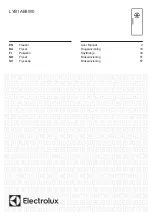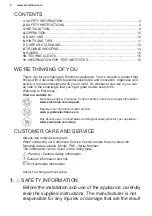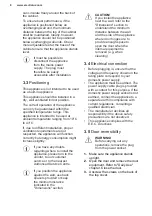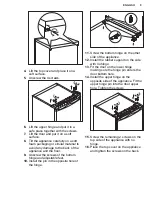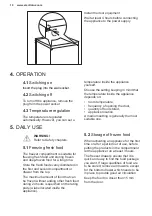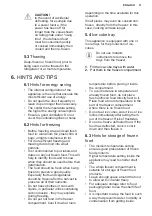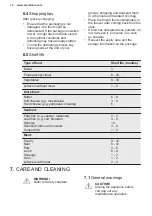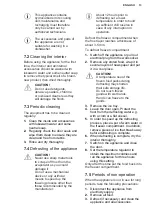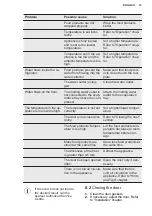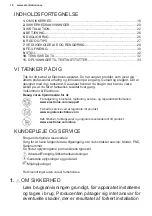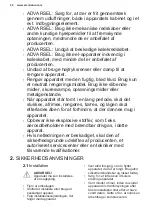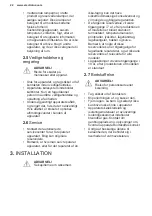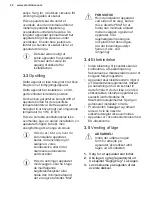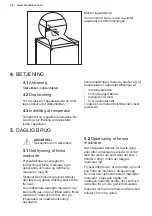
CAUTION!
In the event of accidental
defrosting, for example due
to a power failure, if the
power has been off for
longer than the value shown
on rating plate under "rising
time", the defrosted food
must be consumed quickly
or cooked immediately then
cooled and then re-frozen.
5.3 Thawing
Deep-frozen or frozen food, prior to
being used, can be thawed in the
refrigerator or at room temperature,
depending on the time available for this
operation.
Small pieces may even be cooked still
frozen, directly from the freezer: in this
case, cooking will take longer.
5.4 Ice-cube tray
This appliance is equipped with one or
more trays for the production of ice-
cubes.
Do not use metallic
instruments to remove the
trays from the freezer.
1. Fill the ice-cube trays with water
2. Put them in the freezer compartment.
6. HINTS AND TIPS
6.1 Hints for energy saving
• The internal configuration of the
appliance is the one that ensures the
most efficient use of energy.
• Do not open the door frequently or
leave it open longer than necessary.
• The colder the temperature setting,
the higher the energy consumption.
• Ensure a good ventilation. Do not
cover the ventilation grilles or holes.
6.2 Hints for freezing
• Before freezing wrap and seal fresh
food in: aluminium foil, plastic film or
bags, airtight containers with lid.
• For more efficient freezing and
thawing divide food into small
portions.
• It is recommended to put labels and
dates on all your frozen food. This will
help to identify foods and to know
when they should be used before their
deterioration.
• The food should be fresh when being
frozen to preserve good quality.
Especially fruits and vegetables
should be frozen after the harvest to
preserve all of their nutrients.
• Do not freeze bottles or cans with
liquids, in particular drinks containing
carbon dioxide - they may explode
during freezing.
• Do not put hot food in the freezer
compartment. Cool it down at room
temperature before placing it inside
the compartment.
• To avoid increase in temperature of
already frozen food, do not place
fresh unfrozen food directly next to it.
Place food at room temperature in the
part of the freezer compartment
where there is no frozen food.
• Do not eat ice cubes, water ices or ice
lollies immediately after taking them
out of the freezer. Risk of frostbites.
• Do not re-freeze defrosted food. If the
food has defrosted, cook it, cool it
down and then freeze it.
6.3 Hints for storage of frozen
food
• The medium temperature setting
ensures good preservation of frozen
food products.
Higher temperature setting inside the
appliance may lead to shorter shelf
life.
• The whole freezer compartment is
suitable for storage of frozen food
products.
• Leave enough space around the food
to allow air to circulate freely.
• For adequate storage refer to food
packaging label to see the shelf life of
food.
• It is important to wrap the food in such
a way that prevents water, humidity or
condensation from getting inside.
ENGLISH
11
Summary of Contents for LYB1AE8W0
Page 83: ......

